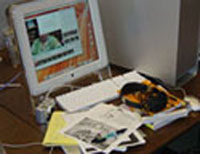
 |
Integrating multimodal writing assignments into high school English classrooms seems a natural fit in many ways since students' earlier experiences in language arts instruction often includes multimodal elements. For example, in the past and even today, typical elementary language arts instruction might find students employing construction paper, scissors, and crayons as they write, create, and illustrate their own books. And while these particular examples do not include technological modalities, they are multimodal by Pamela Takayoshi, Gail Hawisher, and Cynthia Selfe's (2007, p. 1) definition in that they "exceed the alphabetic" and incorporate "images, . . .color, and words . . ." Still, by the time these same students reach high school, their writing instruction is often devoid of these multimodal elements, perhaps because such elements may (ironically) seem pedestrian or unbefitting a more scholarly mode of learning. Takayoshi, Hawisher, and Selfe (2007, p. 1) note this somewhat sterilized notion of writing when they state:
For many . . .teachers at both the secondary and collegiate
levels, the texts that students have produced in response to
composition assignments have remained essentially the same
for the past 150 years. They consist primarily of words on a page, arranged into paragraphs. This flow of words is only occasionally interrupted by titles, headings, diagrams, or footnotes.
As a result, while the 21 st Century has arrived replete with "moving images, animations, sounds, graphics, words, and colors" across its Internet landscape, "students are producing essays that look much the same as those produced by their parents and grandparents" (Takayoshi, Hawisher, & Selfe, 2007, p. 2).
Unfortunately, such an approach to composition prohibits today's student writers and their overall learning in a number of ways. As far as the digital aspect of multimodal writing instruction is concerned, it was as early as 1983 that Janet Emig argued for computer-based instruction as a means to effectively contribute to "writing as a mode of learning" (as cited in Reed, 2007). Two decades later, Kathleen Blake Yancey's (2007) admonition that "Helping writers develop fluency and competence in a variety of technologies is a key part of teaching writing in this century" suggests the foresight of Emig's claim. That is not to say, though, that all means of multimodal writing instruction must be digital; in fact, Selfe is quick to point out the "lingering high culture/low culture bias" that may exclude some populations of learners from engaging in such learning opportunities (personal communication, July 5, 2007), and as a result,
encourage(s) teachers to develop an increasingly thoughtful understanding of a whole range of modalities and semiotic resources in their assignments , and, then to provide students the opportunities of developing expertise with all available means of persuasion and expression, so that they can function as literate citizens in a world cultural, and linguistic borders (Selfe, forthcoming, p. 2).
For Dr. Cindy Selfe's and pre-service teacher Jeremy Brown's views, play the videos to the right of your screen.